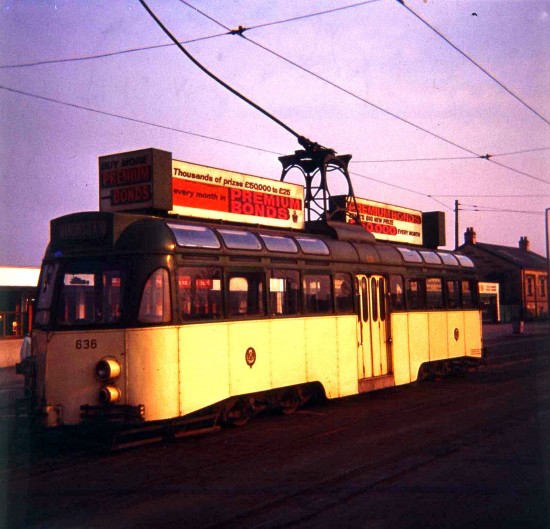Today’s Picture in Time is a tram we have featured before but this time our view of Blackpool Brush 636 is from an earlier period in the trams history – 1974.
This view of 636 shows the tram sitting out time before heading back to Manchester Square at the old Fleetwood Ferry loading stop during 1974. The tram is carrying the plain half green and half cream livery style with gold fleet numbers and also of note is the roof advert boxes which in this case had adverts for Premium Bonds where, at this time, you could win up to £50,000 if your numbers came up. The tram also still has roof windows and indeed 636 was the last of the Brush Cars to have these with them not being removed until the 21st century.


I always wondered why those Brush railcoaches converted to VAMBAC and resilient wheels did not retain their resilient wheels when the VAMBAC was decommissioned. Those cars rode so smoothly and quietly, as we now see with all new trams. Come to think of it, why were the Balloons not provided with resilient wheels; it was those wheels which produced SILENT trams. Walter Luff would have seen to all that.
The Marton VAMBACs were converted from English Electric trams and were scrapped when the Marton route was abandoned, except for one now at Carlton Colville.
I seem to remember that the rubber in the sandwich suffered from Vulcanisation with the brake shoes acting on the tyre and heating the wheel. There was also mention of the slight lateral play in the wheel giving problems with single-tongue points used on some parts of the system.
Can anybody confirm this?
Only one Brush car – No 303 – was ever fitted with Vambac Controls. It was scrapped without ever being converted back.
The only trams converted from Vambac to normal controlers were 13 of the Coronations, and they DID retain the resilient wheels…
Only one Brush car was converted to VAMBAC equipment. 303 was the car involved and was fully operational by 1952. The other railcoach conversion was English Electric Series 1 car 208 in 1946. 208 operated alongside the Marton VAMBACs 10 to 21 on the Marton route until withdrawal in 1963 along with the rest of the Marton cars. 303 similarly was withdrawn and scrapped the same year. Both cars still had VAMBAC equipment when withdrawn. Their demise was partly due to their non standard status and complex equipment.
It was a number of the later Coronation VAMBAC cars which lost their equipment and were converted to normal control using equipment from withdrawn Series 1 railcoaches. They retained their resilient wheel bogies though.
The problem with the VAMBAC equipped cars was their complexity and poor reliability compared with the older equipment. Maintenance was costly and power consumption high.
With regard to the rubber sandwiches used on resilient wheels, it is true that they could be subject to vulcanization; however the break shoes operated on special braking discs at the ends of the axles (a bit like the smaller weight at the end of a weightlifter’s bar), which minimised heating of the rubber when braking. Indeed, the VAMBAC Coronations also originally benefited from magnetic track brakes, although these were later removed, especially from the time of the de-VAMBAC-ing programme. Note that they have been restored on 304. I think a lot of noise problems with the Z4 Coronations towards the end was down to lack of maintenance of the brake rigging. Performance was quite variable and I recall in October 1973 travelling on 661 and 662 on the same day. What a difference! 661 was a veritable rattle trap and when the brakes were applied it sounded as though a milk float had just crashed. 662 by contrast was exceptionally smooth – most notable with street running in Fleetwood and managed all of the tight corners without any signs of the regular grinding you got from these cars on curves. All this having been stated, one has to ask whether a system such as Blackpool and Fleetwood really needed the innovation of resilient wheels given that a very small percentage of the surviving route is actually street running and as we have seen noise problems are very satisfactorily addressed by regular rail grinding. It is worth noting that the EMB bogies on which the Brush Railcoaches ran were of lighter construction than the EE bogies and had less of a resonating ‘ring’ on corrugated street track making the trams less offensive noise-wise.